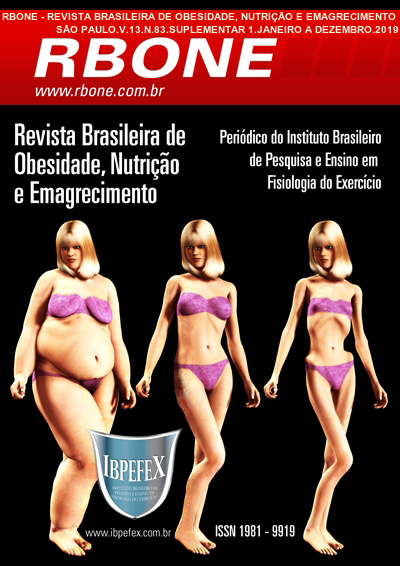Consumption of total fat and saturated, unsaturated and trans fatty acids by diabetic patients attended at the Nutrition clinic of a reference center in southern Brazil
Abstract
Objective: To evaluate the consumption of total fats and saturated, unsaturated and trans fatty acids by diabetic patients treated at the Diabetes and Hypertension Center of the Federal University of Pelotas. Method: cross-sectional study with type 2 diabetic patients, over 18 years old, of both sexes, performed between the months of March and June of 2018. Secondary data obtained through the charts of the patients treated at the Nutrition clinic will be retrospectively evaluated. The analysis of the consumption of total fats and fatty acids was obtained through the 24-hour recall, applied at the first consultation of the patients. Results: A total of 214 type 2 diabetic patients were evaluated, being the majority female (68.22%). The majority were overweight (95.33%) and 95.28% had abnormal abdominal circumference. Regarding fat consumption, it was observed that total saturated and polyunsaturated fat intake exceeded the limits recommended by SBD, while monounsaturated and trans-fat were within the limits established by the guideline. According to the characteristics of the patients, significant statistical differences were found between total and monounsaturated fat consumption in relation to schooling, showing a higher consumption by those who had completed high school or college. We also found an association between the consumption of monounsaturated fat and trans-fat in relation to the patients' gender. Conclusion: There was a high intake of fats, mainly saturated, predictive of risk for coronary disease, not meeting the recommendation proposed by SBD.
References
-American Diabetes Association-ADA. Standards of medical care in diabetes -2010. Diabetes Care. Vol. 33. Núm. 1. p. 11-13. 2010.
-Arcânjo, G.N.; Neto, P.S.P.; Nobre, M.M.A.; Oliveira, A.A.R.; Alencar, D.L.; Gadelha, M.A. Indicadores antropométricos de obesidade em mulheres diabéticas tipo 2. Motricidade. Vol. 14. Núm. 1. p. 362-367. 2018.
-Brasil. Ministério da Saúde. Secretaria de Atenção à saúde. Departamento de Atenção Básica. Diabetes Mellitus: Caderno de Atenção Básica, n 16 Série A. Brasília-DF. Normas e Manuais Técnicos. 2006. Disponível em: <http://bvsms.saude.gov.br/bvs/publicacoes/diabetes_mellitus_cab16.pdf>
-Brunerova, L.; Smejkalova, V.; Potockova, J.; Andel, M. A comparison of the influence of a high-fat diet enriched in monounsaturated fatty acids and conventional diet on weight loss and metabolic parameters in obese non diabetic and type 2 diabetic patients. Diabet Med. p. 33-40. 2007.
-Carvalho, F.S.; Netto, A.P.; Zach, P.; Sachs, A.; Zanella, M.T. Importância da orientação nutricional e do teor de fibras da dieta no controle glicêmico de pacientes diabéticos tipo 2 sob intervenção nutricional intensiva. Arquivos Brasileiros de Endocrinologia e Metabologia. Vol. 56. Núm. 2. p. 110-119. 2012.
-Estruch, R.; Ros, E.; Salas-Salvadó, J.; Covas M.I.; Corella, D.; Arós, F.; Gómez-7-Gracia, E.; Ruiz-Gutiérrez, V.; Fiol, M.; Lapetra, J.; Lamuela-Raventos, R.M.; Serra-Majem, L.; Pintó, X.; Basora, J.; Muñoz, M.A.; Sorlí, J.V.; Martínez, J.A.; Martínez-González, M.A. Predimed Study Investigators. Primary prevention of cardiovascular disease with a Mediterranean diet. N Engl J Med. p. 1279-1290. 2013.
-Felippe, J.B.; Bongiolo, A.M. Consumo de ácidos graxos saturados, insaturados e trans por pacientes cardiopatas de Unidades de Saúde de Criciúma-SC. Rev Bras Nutr Clin. Vol. 25. Núm. 3. p. 213-217. 2009.
-Ministério da Saúde. Secretaria de Vigilância em Saúde. Departamento de Vigilância de Doenças e Agravos não Transmissíveis e Promoção da Saúde. Vigitel Brasil 2014. vigilância de fatores de risco e proteção para doenças crônicas por inquérito telefônico. Brasília. Ministério da Saúde. 2015.
-Santos, C.R.B.; Portella, E.S.; Avila, S.S.; Lanzillotti, H.S.; Soares, E.A. Avaliação nutricional de pacientes diabéticos tipo 2 / Nutritional evaluation of type 2 diabetic patients. Rev. Ciênc. Médic. p. 119-128. 2005.
-Schwingshackl, L.; Strasser, B.; Hoffmann, G. Effects of monounsaturated fatty acids on glycaemic control in patients with abnormal glucose metabolism: a systematic review and metaanalysis. Ann Nutr Metab. p. 90-96. 2011.
-Sociedade Brasileira de Cardiologia. Arquivos Brasileiros de Cardiologia. 2013. Internet. Rio de Janeiro. Disponível em: http://publicacoes.cardiol.br/consenso/2013/Diretriz_Gorduras.pdf
-Sociedade Brasileira de Diabetes. Diretrizes da Sociedade Brasileira de Diabetes, 2015-2016. São Paulo. 2016. Disponível em: <http://www.diabetes.org.br/profissionais/images/docs/DIRETRIZES-SBD-2015-2016.pdf>
-Sociedade Brasileira de Diabetes. Diretrizes da Sociedade Brasileira de Diabetes, 2017-2018. São Paulo. 2016. Disponível em: <https://www.diabetes.org.br/profissionais/images/2017/diretrizes/diretrizes-sbd-2017-2018.pdf>
-World Health Organization. Obesity: preventing and managing the global epidemic. WHO Technical Report Series. Geneva. Núm. 894. 1998. Disponível em: <http://www.who.int/nutrition/publications/obesity/WHO_TRS_894/en/>
-Zanetti, M.L.; Arrelias, C.C.A.; Franco, R.C.; Santos, M.A.; Rodrigues, F.F.L.; Faria, H.T.G. Adesão às recomendações nutricionais e variáveis sociodemográficas em pacientes com diabetes mellitus. Rev. Esc. Enferm. USP Vol. 49. Núm. 4. p. 619-625. 2015.
Copyright (c) 2020 Andressa Mello Teixeira, Renata Torres Abib, Lúcia Rota Borges

This work is licensed under a Creative Commons Attribution-NonCommercial 4.0 International License.
Authors who publish in this journal agree to the following terms:
- Authors retain the copyright and grant the journal the right of first publication, with work simultaneously licensed under the Creative Commons Attribution License BY-NC which allows the sharing of the work with acknowledgment of the authorship of the work and initial publication in this journal.
- Authors are authorized to enter into additional contracts separately for non-exclusive distribution of the version of the work published in this journal (eg, publishing in institutional repository or book chapter), with acknowledgment of authorship and initial publication in this journal.
- Authors are allowed and encouraged to post and distribute their work online (eg, in institutional repositories or on their personal page) at any point before or during the editorial process, as this can bring about productive change as well as increase impact and impact. citation of published work (See The Effect of Free Access).






